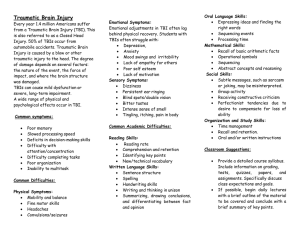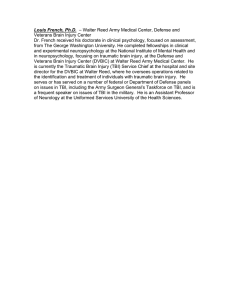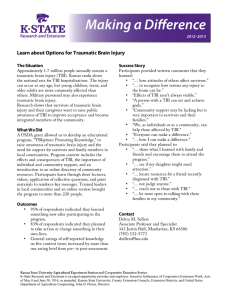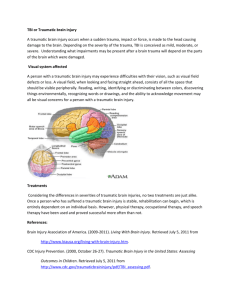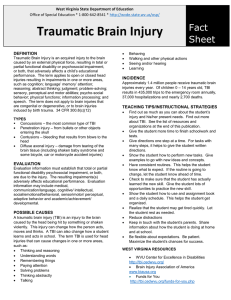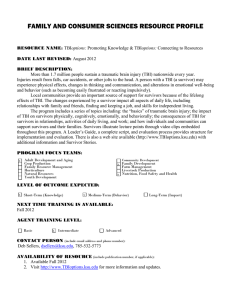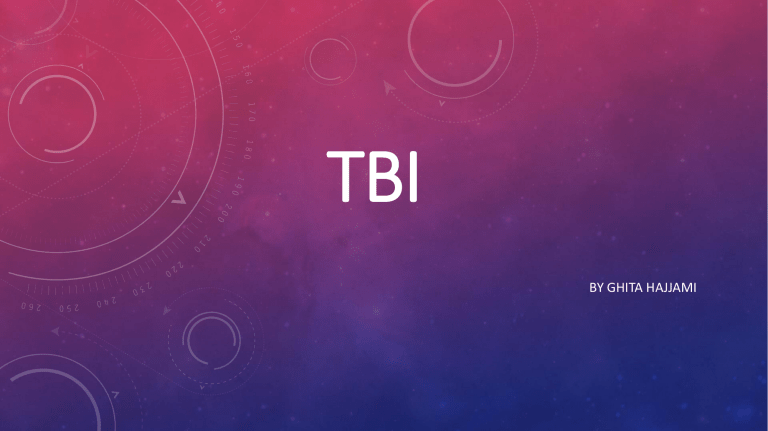
TBI BY GHITA HAJJAMI TBI TBI= Mild traumaitc injury Traumatic brain injury (TBI) is a nondegenerative, noncongenital insult to the brain from an external mechanical force, possibly leading to permanent or temporary impairment of cognitive, physical, and psychosocial functions, with an associated diminished or altered state of consciousness. Definition: MECHANISM OF ACTION OF MILD TRAUMATIC INJURIES • 1. Trauma • 2. Impaired neuronal communication • 3. Brain metabolic imbalance • 4. Excessive inflammation POSSIBLE CAUSES OF TBIS • Falls • Vehicle-related collisions • Violence: gunshots, domestic violence, child abuse, assaults • Sports injuries: Concussions • Explosiive blasts and other combat injuries • TBIs can also results from penetrating wounds, severe blows to the head, falls, and bodily collisions • • • • • • • • • • • • Headache . Balance and sleep impairements Behavioral changes Psychological symptoms ( anxiety, Depression…) Dizziness Concentration Deficits Confusion Blurred vision Light and Sound Sensivity Fatigue SYMPTOMS OF MILD TBI Nausea Amnesia Loss of consciousness SEVERE TBI COMPLICATIONS ( ALTERED CONSCIOUSNESS) . Moderate to severe traumatic brain injury can result in prolonged or permanent changes in a person's state of consciousness, awareness or responsiveness. Different states of consciousness • Coma • Vegetative state: Widespread damage to the brain that can result in a vegetative state • Minimal conscious state: A minimally conscious state is a condition of severely altered consciousness but with some signs of self-awareness or awareness of one's environment. • Brain death: No measurable activity in the brainstem. Irreversible. SEVERE TBI COMPLICATION PART 2 • Seizures • Hydrocephalus: Fluid buildup in the brain • Blood vessels damages • Vertigo • Cognitive problems: Difficulty speaking/understandingwriting, inability to organize ideas and thoughts. • Social problems: Dysarthria • Behavioral changes: self-control, risky behavior • Emotional changes: anger, insomnia, irritability… • Sensory problems: double vision, bitter taste, blind spots… • Degenerative brain diseases: Parkinson’s, Alzheimer’s… DIAGNOSTIC TOOLS • 1. Glasgow Coma Scale: 15-point test helps emergency medical workers assess the initial severity of a brain injury by checking the ability to follow directions and move their eyes and limbs. The coherence of speech also provides important clues. • 2. imaging Tests: Computerized tomography (CT) scan, Magnetic resonance imaging (MRI). • 3. Intracranial pressure monitor • 4. Questions TREATMENTS • Mild Injury: Rest, over the counter pain killers (tylenol), close monitoring, limit physical and cognitive activities. • Medications: Diuretics, Anti-seizures drugs, Coma-inducing drugs… • Surgeries: Craniotomy… • Rehabilitation: PT, OT, Social worker, Rehabilittion Nurse, TBI nurse specialist… • Coping and support: support group, write things down… NURSING ASSESSMENTS • Assessments 1. Disturbance in level of consciousness from slightly drowsy to unconscious. 2. Headache, vertigo, agitation, and restlessness. 3. Cerebrospinal fluid leakage at ears and nose, which may indicate skull fracture. 4. Contusions about eyes and ears indicating skull fractures. 5. Irregular respirations 6. Cognitive deficit 7. Pupillary abnormality 8. Sudden onset of neurologic deficits 9. Otorrhea indicating posterior fossa skull fracture 10. Rhinorrhea indicating anterior fossa skul fracture NURSING INTERVENTIONS 1. Maintain ICP monitoring, as indicated, and report abnormalities. 2. Maintain patent airway; assist with intubation and ventilatory assistance is needed. 3. Turn the patient every 2 hours and encourage coughing and deep breathing. 4. Apply firm pressure over puncture site for subdural trap and observe for drainage and dressing. 5. Suction the patient as needed. 6. Institute measures to prevent increased ICP or other neurovascular compromise. 7. Feed the patient as soon as possible after a head injury and administer histamine-2 blockers to prevent gastric ulceration and hemorrhage from gastric acid hypersecretion. 8. If the patient is unable to swallow, provide enteral feedings after bowel sounds have returned. 9. Elevate the head of the bed after feedings, and check residuals to prevent aspiration. 10.Monitor respiratory rate, depth, and pattern of respirations. 1. Traumatic Brain Injury Nursing Management – Rnpedia 2. Traumatic brain injury - Symptoms and causes - Mayo Clinic 3. Traumatic brain injury - Diagnosis and treatment - Mayo Clinic 4. Lecture 8 - Sport Concussions.pdf Sources
